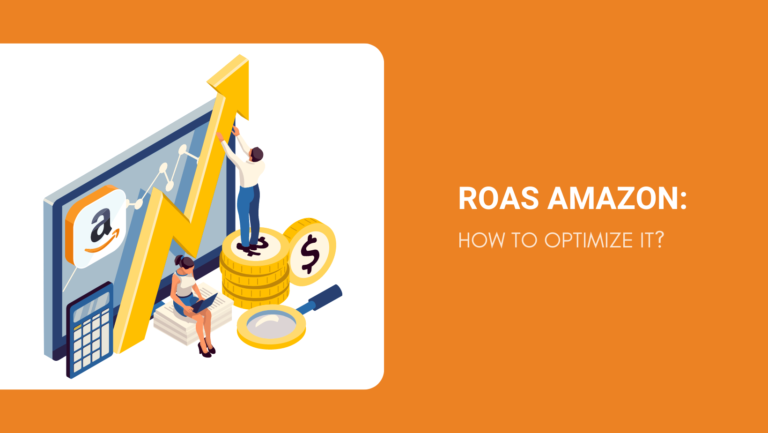Amazon is a massive marketplace that also comes with huge competition. You can’t just rely on organic ways to reach your audience. You also have to run paid advertisements on Amazon to be noticed earlier than your competitors.
If you’re planning to run paid advertisements on Amazon, you need to be crystal clear about the RoAS. That decides whether you are spending your precious money in the right direction or you need to make some changes.
This article discusses everything about RoAS on Amazon and what you can do to maximize it.
Let’s start.
What Is RoAS?
RoAS is short for “Return on Advertising Spend”. As the name suggests, it indicates what you are getting for running advertisements on Amazon.
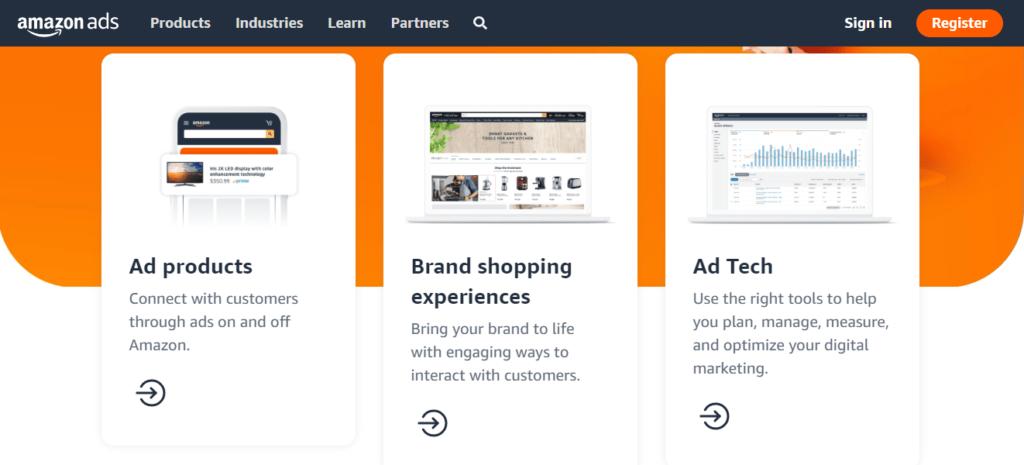
It is calculated as a number donating the revenue earned for every dollar spent on ads.
Every seller who advertises on Amazon has a common purpose of reaching more potential customers. They expect to increase sales and customer engagement in their stores. This also helps increase their store’s rankings to be able to get more Amazon Buy Boxes.
That’s why they pay Amazon to run sponsored advertisements so that their products show up on top of the results for specific keywords that users search.
You can think of RoAS as ROI (Return on Investment). Every business owner invests money to get the desired returns. Your ad spend is the investment in the case of RoAS.
It is widely used in e-commerce and shows what paid advertisements are bringing you to the table.
How to Calculate RoAS?
The return on ad spend can be calculated in multiple ways. In addition to the revenue, it can be also calculated using the number of orders or any other desired metric that a seller wants.

In a few cases, ads can also be aimed at reaching as many people as possible but since Amazon is an online retail platform, most sellers calculate RoAS in terms of revenue or sales.
The objectives of Amazon advertising will be discussed later in this article.
There is a simple formula to calculate RoAS on Amazon as follows.
RoAS = Total Ad Revenue/Total Ad Spend
Total ad revenue means the total sales value that you got from running advertisements or sponsored ads.
The total ad spend means the total amount you spend on running advertisements.
Both total ad revenue and total ad spend will be calculated in dollars or any relevant currency.
As an example, if you spend $1000 in advertisements and get $5000 in sales revenue, the RoAs will be as follows.
RoAS = $5000/$1000
So, the RoAS in this case will be 5.
In other words, you earn $5 for every dollar you spend on ads. This is considered a profitable ad campaign as you are getting more than you are spending. As long as the sales revenue is higher than the ad spend, a seller will most probably keep the ad campaign alive.
What Is a Good RoAS on Amazon?
Yes, it is possible not to get a single sale even by running paid ads. It especially happens when your ad campaign is new.
That’s why you need to monitor your RoAS regularly to decide whether the paid advertisements are worth your ad spend.
You have to be sure of a good or bad RoAS. So, what is a good RoAS on Amazon?
As a general rule of thumb, the RoAS of 4 to 5 and higher is considered good but if you have just started selling on Amazon, you can also rely on a RoAS of 3 if you expect to increase it in the future.
How to Find Your Minimum RoAS?
There is no upper limit for the profit but you can’t afford to go below the minimum RoAS. But how do you know the minimum RoAS for your ad campaigns to avoid losses?

First of all, you need to calculate the profit that you make from a sale without running ads. Following is a simple formula for calculating profit.
Profit = Product Price – Costs
The costs include everything from the product’s purchase price, storage, shipping, operational costs, Amazon fees, etc.
For example, if your product’s price is $60 and the cost per product is $40, your profit per sale would be $20.
In short, you earn $20 with every sale of your product on Amazon without ads. So, you can set the minimum profit for your advertisements to be $20 or more to consider your ad campaign successful.
If you earn less than $20 per product with paid advertisements, it would mean that your ads aren’t successful as they are reducing your profit per sale.
If you can earn $20 or more by running ads on Amazon, it means your ad campaigns are successful.
So, we can set the formula of minimum RoAS as follows.
Minimum RoAS = Product’s Sale Price/Minimum Profit per Product
The minimum profit is also referred to as the break-even point on Amazon.
Putting in the values from the example discussed above, we get the minimum RoAS as follows.
Minimum RoAS = $60/$20 = 3
So, your minimum RoAS in this case should be $3 for every dollar you spend on ads. If the RoAS is above 3, it is good news but if your RoAS is below 3, your ad campaign is in hot waters.
The minimum RoAS will differ from case to case. Just remember to add up all the costs and divide them by the number of products you have in stock to get the correct cost per product.
What Types of Ad Campaigns Have the Best RoAS on Amazon?
You can run the following three types of ads on Amazon. All the ads run on the PPC campaign (Pay Per Click) method and you have to set your ads as per the search keywords.
1. Sponsored Brand Ads
As its name suggests, sponsored brand ads are meant to promote your brand along with its products. This is placed at the top of Amazon search results displaying your brand name along with its products.
It was previously known as “Headline Search Ads”. These ads are meant to promote brands against specific search terms (keywords) defined by the sellers.
For example, if you search for “dog shoes” on Amazon, the results may include a specific brand at the top alongside its products that you can click and buy. See the example in the screenshot below.

Sponsored brands have the best and the highest RoAS on Amazon. The way it is shown and the space it occupies on the result pages is more appealing and the users are more likely to buy products from that brand.
Only the brands registered with Amazon can run the sponsored brand ads. When you click it, you are redirected to a dedicated page that displays products from that brand only.
You may notice that these product pages stand out from the rest because Amazon allows brands to make a dedicated page on the platform that looks like a website within Amazon. These brands use Amazon EBC methods to improve their content display.
2. Sponsored Display Ads
These types of ads promote your brands differently as they show your brands in different locations on the search results.
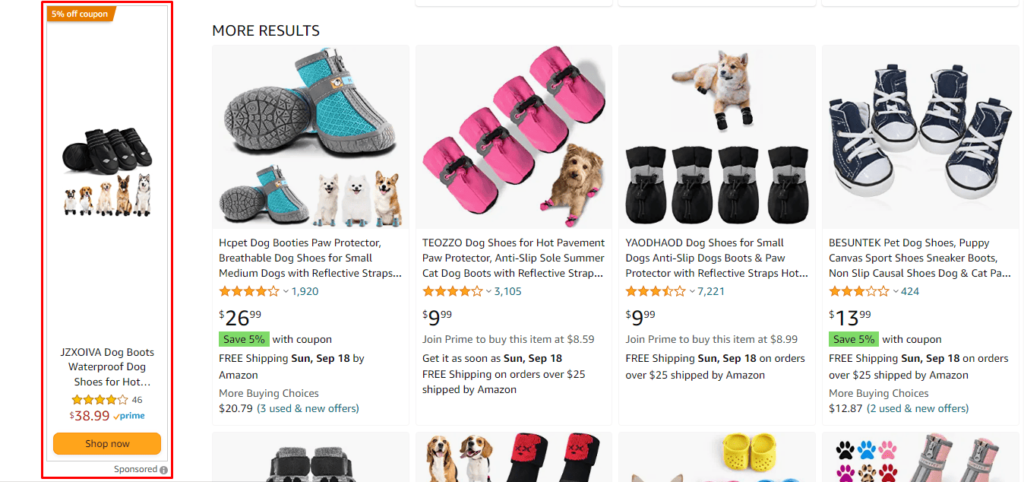
The display is generally in a banner form that attracts the users.
Again, these ads are also targeted as per the given keywords but Amazon also uses its algorithms and bots to decide where to display your ads.
Sponsored display ads have the third-best RoAS on Amazon but it doesn’t mean that this type of ad is the least effective.
As discussed earlier, higher RoAS is not the only factor determining a successful ad campaign. The sellers may be achieving their targets to reach more potential customers just by showing them their brands in the form of banners.
3. Sponsored Product Ads
If you have been an Amazon user, you know this ad category already. These ads are shown on Amazon’s search page along with the organic results.
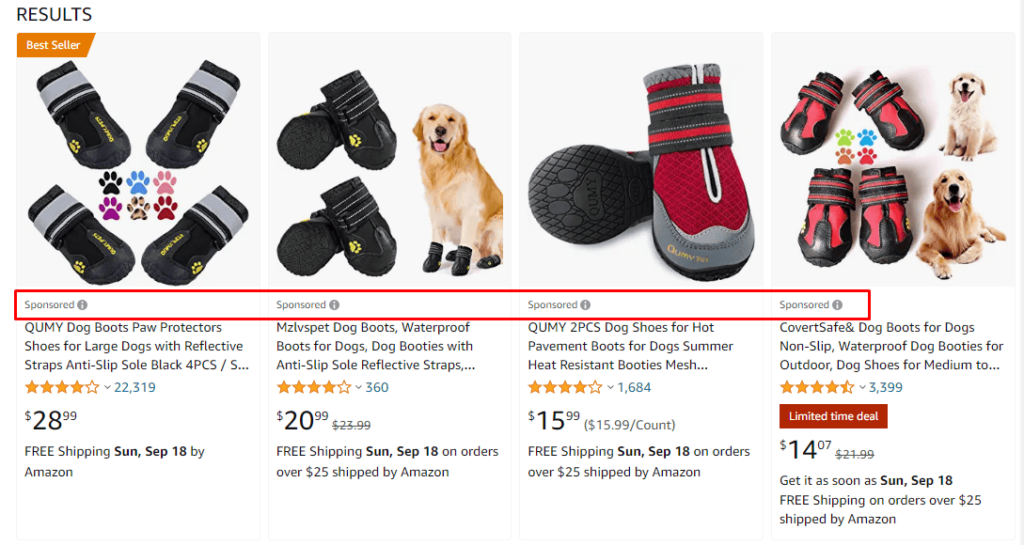
Sponsored product ads are considered to yield the second-best RoAS on Amazon. That is because the users usually start looking at the results where all the products are shown collectively.
So, there is no simple answer to decide which type of ad campaign is best. It all depends on your choices and objectives from running advertisements on Amazon.
Where to Find Your RoAS in Seller Central?
Amazon helps you provide RoAs for your ad spend. You can find this on your Amazon Seller Central Account.
You can go to Seller Central and then click “Advertising” from the main options and then click “Campaign Manager”.
You will be able to see the following metrics in your advertising dashboard.
- Spend – Total amount spent on advertising
- Sales – Total sales from your ads
- RoAS – Return on ad spend
- Impressions – Number of times your ads were shown on Amazon
You will notice that RoAS will be shown as a number. You can compare this number from your minimum RoAS as discussed in the earlier section and decide whether your ads are performing or they require some changes.
RoAS Tactics
Let’s discuss some tips or professional tactics that can help increase your RoAS. Consider using the following strategies to refine your ad campaigns and increase your RoAS.
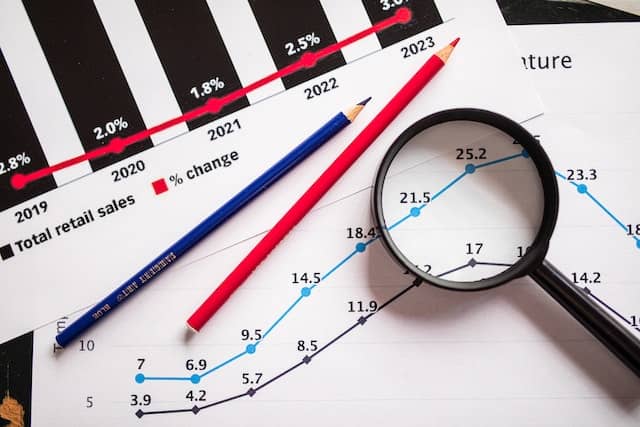
Choose Ad Campaigns Wisely
You need to do things correctly right from the start. Before advertising on Amazon, you have to be crystal clear about what you want to get in return.
A low RoAS is not always a result of a bad ad campaign. If your objective was different from just getting sales, your ad campaign might be good to go even with a low RoAS value.
So, you need to think hard before running an ad on Amazon. To brief it up, you may consider running sponsored brands and sponsored display ads if you are registered on Amazon.
You may go for sponsored product ads if you are just after getting some extra sales.
Exact Match Keywords
Go for the traffic that is there on Amazon exactly what you are selling. You can do this by targeting the users who search for the exact keywords that you give to Amazon.
Although this may cost you higher as compared to using broader keywords or partial matches (phrase match), you will be confident when you get the desired results.
Increase Average Order Value
Increasing your AOV (Average Order Value) will also help you increase your average RoAS. A highly recommended way to increase your AOV is cross-selling and upselling techniques.
You can also sell product bundles as a single package to increase your AOV. This will certainly reflect in your RoAS.
Use Amazon Tools
Don’t just count on Amazon’s metrics. You should consider using advanced tools to find profitable keywords so that you can target the right ones.
If you are not in a position to use the best paid Amazon tools, you can use free Amazon tools. They will also help you stand out from the ones who are just relying on Amazon’s built-in tools.
Sale Offers
Customers love discounts. You can also increase your RoAS by reducing the sale prices of your products. Although it would reduce your profit margins, ultimately you will get increased sales.
Selling 5 products at a $10 profit margin is the same as selling 10 products at a $5 profit margin.
So, you have to reduce the prices carefully so that you remain profitable at the end of the day.
Your ads will most probably see a boom when you offer discounts in your Amazon ad campaigns.
Target Less Expensive Keywords
While targeting exact match keywords is a wonderful way of reaching the most relevant audience, it is also the most expensive. That’s because exact match keywords or the general or broader terms like “shirts”, “shoes”, etc have the highest cost per click.
So, you can target low-cost keywords that are related to your niche. They may not have a huge audience but they may turn out to be profitable by getting sales at low bid amounts.
Split Testing
Split testing is a popular concept in almost every kind of ad. You are not sure if your ad campaign will perform with the criteria you set at the start. That’s why it is often advisable to run different ad campaigns with different targeting strategies.

In this way, you will be in a better position to judge which ad campaign is performing better than the others so that you focus on the ad campaign with the best RoAS and kill the rest.
Scale With the Right Metrics
If your ad campaigns are performing well, don’t just stop there. You may consider increasing your targeting areas and scaling your business to global to unleash the true potential of your winning products.
FAQs about RoAS Amazon
The following answers to the frequently asked questions will strengthen your understanding of RoAS Amazon.
What Is ACoS vs RoAS on Amazon?
ACoS stands for Advertising Cost of Sales on Amazon. As it is related to the costs of advertising, it differs largely from RoAS. Here is the formula to calculate the ACoS.
ACoS = Ad Spend/Ads Revenue
For example, if you have spent $50 on Amazon ads and got a revenue or sales worth $$200, your ACoS will be as follows.
ACoS = $50/$200 = 0.25
As ACoS is generally calculated in percentage, we multiply the answer with 100 to get the ACoS percentage. So, in this case, our ACoS will be 25%.
Can RoAS Be Measured in the Percentage?
Yes. Although it is in number form by default, you can also measure the RoAS in percentage. Let’s understand this with an example.
If your RoAS is 4, you earn $4 with every $1 spent on ads. In other words, your return is 4 times the amount you spend on ads.
This automatically translates into 400 in terms of percentage. Simple maths.
So, in this case, your RoAS will be 400%.
Can Amazon PPC Automatic Campaign Increase RoAS?
Not necessarily. Amazon PPC auto campaigns are run by Amazon and it may take time to self-optimize.
Their results may also surprise you positively sometimes because the auto advertising campaigns target the potential keywords that you haven’t even thought of.
Still, they are not always guaranteed to increase RoAS. You should optimize your ads to remain safe.
Summary
RoAS is important to measure your success especially if you are into running paid advertisements on Amazon. You can’t play around when every click is costing money from your business.
Don’t lose hope if you are not getting the desired or standard RoAS. You can overturn your ad performances by making minor tweaks to your ad campaigns.
One of the reasons for a low RoAS on Amazon is sourcing products at higher costs. If you want to source products directly from manufacturers, ask for a free quote and we will be right there to make your business profitable.
